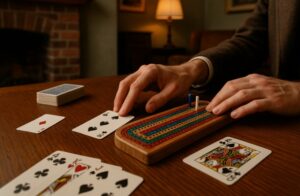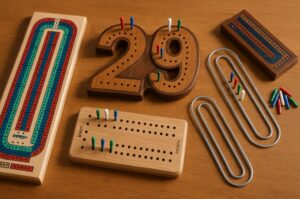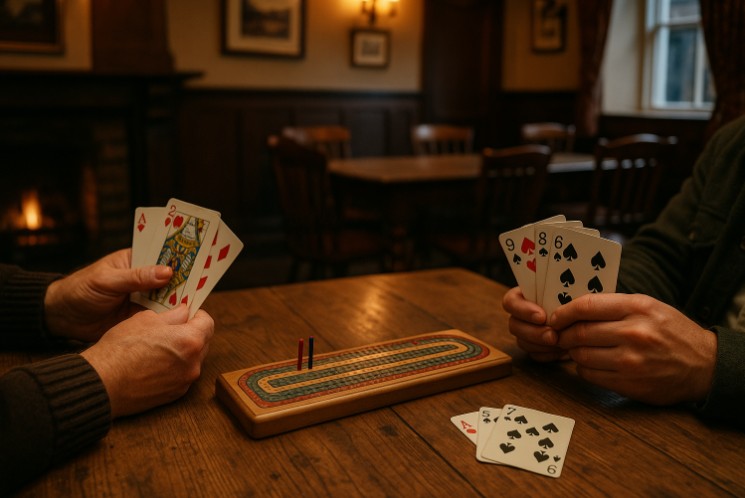Cribbage, also known simply as “crib,” is a classic English card game that blends strategy, counting, and chance. Played with a standard 52-card deck and a unique pegged scoring board, cribbage offers a distinct gaming experience that has stood the test of time.
Popular across pubs and homes in the UK, the game’s structured rules and subtle tactics make it engaging for players of all skill levels. This guide explores its setup, rules, and how to play effectively.
What Is The Crib Card Game And How Is It Played?

Cribbage, often shortened to crib, is a traditional English card game primarily designed for two players, though it can be played by three to four with some variations. It belongs to the matching family of card games and is known for its unique pegging board used for scoring.
The game involves playing and grouping cards to form specific scoring combinations. Players aim to be the first to reach a pre-determined score, usually 121. A key component is the “crib,” a separate hand that belongs to the dealer and is scored at the end of the round.
The use of a cribbage board, split into 120 holes, allows players to peg their points throughout the game, a method that adds a tactile and visual dimension to scoring.
How Do You Set Up A Crib Card Game?
Setting up a crib card game requires a few essential items and a basic understanding of seating and dealing arrangements. Players sit opposite each other in a two-player game or rotate in a clockwise direction for more than two players.
Materials Required
- A standard 52-card deck (no jokers)
- Cribbage board with pegs
- Pen and paper (optional for scorekeeping if no board is available)
Player Configuration
- Two players (standard)
- Variations exist for three to six players
Game Setup
- Each player cuts the deck to determine the first dealer. The player with the lowest card deals first.
- Cards are shuffled and dealt clockwise.
- Each player receives six cards in a two-player game. In a three or four-player game, each is dealt five cards.
Discarding to the Crib
- Players retain four cards and discard the remaining into the crib (the dealer’s side hand).
- The non-dealer then cuts the remaining deck, and the top card of the cut section is revealed as the starter card.
- If the starter is a Jack, the dealer scores two points immediately (known as “his heels”).
What Are The Basic Rules Of Cribbage?
Cribbage is structured around three main phases in each hand: the deal, the play (pegging), and the show. Each phase has specific rules that govern how cards are handled and how points are scored.
Gameplay Flow:
- Players take turns laying down one card at a time.
- The cumulative total of the cards cannot exceed 31.
- Face cards count as 10 points; numbered cards are worth their face value; Aces are worth 1 point.
- The goal is to form scoring combinations during play.
Scoring During Pegging:
- Reach exactly 15: 2 points
- Make a pair: 2 points
- Run of three or more: Points equal to the number of cards in the run
- Total exactly 31: 2 points
- Last card (if not 31): 1 point
Each player must lay down cards if possible. If no card can be played without exceeding 31, the player says “Go,” and play continues with the next person.
Scoring During The Show:
After the play, each player displays their hand and calculates points based on combinations that include the starter card. The dealer also scores the crib hand.
How Does Scoring Work In A Crib Card Game?

Scoring in cribbage is central to the game and involves multiple ways to earn points. Players keep score using a pegging board or on paper. Each score is marked by moving pegs along a series of holes.
Common Scoring Methods:
| Combination | Points |
| Any combination totalling 15 | 2 |
| Pair | 2 |
| Three of a kind | 6 |
| Four of a kind | 12 |
| Run of three | 3 |
| Run of four | 4 |
| Run of five | 5 |
| Flush (4 in hand) | 4 |
| Flush (5 including starter) | 5 |
| One for his nob (Jack of starter suit) | 1 |
Pegging Mechanics:
- Two pegs are used per player to maintain a leapfrog pattern.
- This helps in identifying the previous score in case of miscounts.
- The board is typically divided into four “streets” of 30 points each.
What Are The Different Phases In A Cribbage Game?
Each round of cribbage is split into defined stages. Understanding these phases is crucial to mastering the gameplay.
Phase Breakdown:
- Deal: Players receive their cards and discard into the crib.
- Cut: The non-dealer cuts the deck, and a starter card is revealed.
- Play (Pegging): Players lay cards one at a time, scoring during cumulative play.
- Show: Points are calculated based on card combinations.
- Crib Show: Dealer scores the crib with the starter card.
Sequence Summary Table:
| Phase | Description |
| Deal | Cards are distributed; crib is formed |
| Cut | Starter card is revealed |
| Play | Cards are laid, combinations scored during cumulative play |
| Show | Players reveal hands and score |
| Crib Show | Dealer reveals and scores the crib hand |
What Strategies Can Help You Win At Cribbage?

Winning at cribbage is not purely a matter of luck. While the shuffle and deal introduce chance, the decisions a player makes during pegging, discarding, and card play have a profound effect on the game’s outcome. Understanding strategic principles gives players a consistent edge over opponents, especially in tightly contested matches.
1. Discarding Strategically To The Crib
Your approach to discarding depends heavily on whether you’re the dealer or the non-dealer (pone):
- If you are the dealer, you benefit from scoring the crib. This means you should try to discard cards that are more likely to create scoring combinations. Favour pairs, cards that total to 5, or sequences like 4 and 5, or 6 and 7, which could lead to 15s or runs with the starter card.
- If you’re not the dealer, discard defensively. Avoid giving the dealer helpful cards such as 5s, pairs, or high face cards that could combine for 15. Instead, toss unrelated cards like a King and a 2, which are unlikely to form scoring hands.
Key Tip: Avoid discarding two cards that total 5, 10, or 15 when you’re the non-dealer, as these are often the building blocks of strong crib hands.
2. Maximising Points During Pegging
Pegging—scoring during the play phase—is often underestimated by beginners, but it can swing a game dramatically. Advanced players pay close attention to the cards played and peg aggressively when the opportunity arises.
Smart Pegging Moves Include:
- Holding back cards that can create pairs or runs based on what the opponent plays.
- Forcing the opponent into positions where they must set you up for a score.
- Playing cards like 2 and 3 or 7 and 8 early to bait a 5 or a 10 from your opponent, then completing a 15 or run.
Pegging effectively often involves reading your opponent’s tendencies. If they frequently play conservatively, you can safely be more aggressive with run building. Conversely, if they’re an aggressive pegger, you may want to defend and hold onto breaking their runs or pairs.
3. Playing The Odds With Card Retention
Retaining the right cards in your hand goes beyond forming combinations. It includes understanding the statistical probability of certain starter cards and combinations appearing.
For example:
- The card 5 is statistically the most valuable because many cards (10, J, Q, K) can pair with it to make 15.
- Avoid keeping three cards of the same suit if you’re not close to a flush. The payoff is low unless the cut card matches.
Professional players often memorise average hand values and calculate what they are giving up to keep or discard certain cards.
4. Tracking Cards And Counting
Experienced cribbage players develop a habit of counting cards or at least tracking what has already been played. This tactic allows them to:
- Predict which cards are left in the deck
- Anticipate what the opponent may be holding
- Decide whether to push for a run or block one
While exact counting isn’t always practical for casual players, being aware of trends—such as seeing many face cards played—can inform better decisions during pegging and the show.
5. Adapting Your Strategy Based On Board Position
The location of your pegs on the cribbage board can and should affect your play style. Cribbage is a race to 121 points, and your position relative to your opponent often dictates how aggressive or conservative you should be.
Board Position Considerations:
- If you’re ahead, play safe hands that guarantee you solid points without high risk.
- If you’re behind, take calculated risks—like discarding potentially valuable cards to the crib or pushing for risky pegging combinations—to try and catch up.
- Near the finish line, always prioritise reaching the next milestone (90, 105, 121), even if it means sacrificing a bigger hand. Pegging out or ending the game before your opponent has a chance to play their hand is often the winning move.
6. Managing The Endgame Effectively
One of the most decisive moments in cribbage is the final few rounds before either player reaches 121. During this phase, every point counts, and efficiency becomes vital.
Tips for effective endgame play:
- Count your cards carefully during pegging to avoid missteps.
- Avoid giving your opponent a “Go” if they are close to winning.
- If you’re within 2–3 points of 121, even a low-scoring hand can win you the game with correct pegging or a fortunate cut card.
7. Practising With Intent
Ultimately, the best way to improve at cribbage is through consistent, intentional practice. Many online cribbage platforms and apps offer practice against both AI and real opponents. Use these tools to develop:
- Faster card recognition
- Deeper understanding of hand values
- Improved pegging judgment under pressure
Keep a record of mistakes or near-wins to study later. Over time, small changes in your game can lead to significant performance improvement.
What Is A Cribbage Board And How Is It Used?

The cribbage board is a key component of the crib card game, serving not only as a visual aid but also as an integral part of the scoring system.
Unlike most card games where points are tallied at the end of each round, cribbage requires continuous score tracking during gameplay. The board helps manage this process with clarity and precision.
Purpose And Functionality
The cribbage board is used for pegging, a scoring method unique to cribbage where players move pegs along a series of holes to represent their accumulated points.
Each player uses two pegs, moving them in a leapfrog fashion to track their current and previous score. This system prevents confusion and allows for error correction if a count is missed.
While it’s possible to keep score using pen and paper, cribbage boards are the standard for serious and casual play alike due to their efficiency and traditional appeal.
Typical Features Of A Cribbage Board
Most cribbage boards share a few fundamental characteristics, though their designs can vary:
- Rows of holes arranged for up to 121 points
- Two tracks (or more, depending on the number of players)
- Pegs (often made of wood or metal) used to mark scores
- Game counters or extra holes to track games won in a match
Boards often segment scores into 30-point sections known as streets. For example:
- 1–30 is the first street
- 31–60 the second street, and so on up to 121
This layout allows players to easily assess their position in the game at a glance.
Types Of Cribbage Boards
Cribbage boards come in various designs, each offering a different aesthetic and layout to suit the player’s preference or play format.
| Board Design | Description |
| Traditional Wooden Board | Flat, rectangular with two 60-point tracks (30 out, 30 back). Pegging holes are spaced in fives. Some include a centre hole for finishing. |
| Triangular Board | An older design with three sides and two rows of forty holes per side. Rare and primarily used for collectors or novelty games. |
| Paperclip-Shaped Board | Features 120 holes in a continuous loop resembling a paperclip. Ideal for games played to 121 points. Often brightly coloured. |
| 29-Shaped Board | Designed to resemble the number 29—the highest possible hand in cribbage. It often includes an artistic display of the perfect hand: three fives and a jack. |
| Compact Travel Board | Small, portable versions suitable for travel. Pegs may be stored within the board itself. |
Each type is suited to different game formats, but all serve the same fundamental purpose of tracking scores accurately throughout the game.
Game Pegging And Match Tracking
Some boards come with additional features like match counters—sets of smaller holes used to track games won across a match. In tournaments or extended play sessions, this allows players to peg multiple game victories alongside their current game progress.
Using two pegs per player not only aids in accurate scoring but also enhances the tactical flow of the game, as players can anticipate their opponent’s position and adjust strategies accordingly.
The cribbage board thus forms the visual and practical backbone of the game, enhancing both playability and tradition in equal measure.
How Do You Play Crib Card Game With 2 Players Or More?
Although cribbage is optimally designed for two players, variations allow for three or four players.
Three-Player Variation:
- Each player is dealt five cards.
- One card is dealt face-down to form part of the crib.
- Each player discards one card into the crib.
Four-Player Variation (Teams):
- Players pair off into two teams.
- Each receives five cards and discards one to the crib.
- Teammates sit opposite each other, and scoring is done collectively.
In all versions, the play, scoring, and pegging rules remain consistent, with only the dealing and crib formation rules adjusted.
What Are Common Mistakes And Misconceptions In Cribbage?
Even experienced players occasionally make errors that can affect the outcome of a game. Recognising and avoiding these common pitfalls can improve gameplay.
Frequent Mistakes:
- Forgetting to score pairs or 15s during the show.
- Assuming a four-card flush is valid in the crib (it must be five cards).
- Miscounting runs during pegging.
- Overlooking “His Nobs” points during scoring.
- Misplacing pegs or failing to leapfrog correctly on the board.
Players are encouraged to double-check scores and maintain awareness of rules to ensure fair play.
Can You Learn Cribbage Easily As A Beginner?

Cribbage is approachable for beginners, with simple rules that can be mastered quickly. However, developing advanced strategies takes time and practice.
Beginner Learning Tips:
- Use a cribbage scoring chart as a reference during early games.
- Practice with apps or online simulators to build confidence.
- Focus initially on understanding combinations for 15s, pairs, and runs.
- Gradually learn more complex strategies like optimal pegging and discard tactics.
Cribbage combines the simplicity of basic card games with the depth of strategic board games, making it an ideal pastime for players of all levels.
What Are The Essential Cribbage Terms To Know?
Understanding cribbage terminology helps streamline learning and play. Below are essential terms used throughout the game:
- Crib: The extra hand scored by the dealer
- Pone: The non-dealer in a two-player game
- Pegging: Recording points on the board
- Cut Card (Starter): The revealed card used in scoring
- His Nobs: Jack in hand matching the starter’s suit, worth 1 point
- His Heels: A Jack drawn as starter, scoring 2 points for the dealer
- Go: Called when a player cannot play without exceeding 31
Cribbage’s rich vocabulary reflects its deep history and layered mechanics, adding both charm and precision to gameplay.
Conclusion
Cribbage offers a rare blend of simplicity, mental stimulation, and classic charm. As a game that rewards strategy, memory, and probability skills, it continues to captivate players across generations. Whether you’re new to card games or a seasoned enthusiast, cribbage is both accessible and endlessly rewarding.
With minimal setup and a rich tradition behind it, there’s never been a better time to rediscover one of England’s most enduring card games.
FAQs About the Crib Card Game
What is the difference between a flush in hand and a flush in the crib?
A four-card flush in hand scores 4 points, while a flush in the crib only scores if all five cards (including the starter) are of the same suit.
Why is 19 considered an impossible cribbage hand?
Because no combination of four cards and a starter can total exactly 19 points, players jokingly refer to a zero-point hand as a “19 hand”.
Can cribbage be played without a board?
Yes, though less common, scores can be tracked on paper, but using a cribbage board is highly recommended for accuracy.
What happens if both players reach 121 points in the same hand?
The first player to physically peg 121 wins. Speed can matter during the endgame.
Is muggins an official rule in cribbage?
Muggins is optional. If used, players can claim any unscored points their opponent misses.
What does skunking mean in cribbage?
If one player reaches 121 before the other scores 91, it’s called a “skunk” and counts as two match points in some variations.
How long does a typical game of cribbage last?
A standard two-player game usually takes between 15 to 30 minutes to complete.







